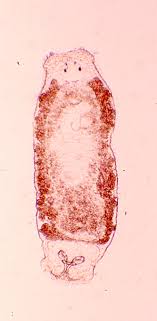
Pseudodactylogyrus anguillae
Platyhelminthes
Pseudodactylogyrus anguillae (Kikuchi (1929), a gill trematode parasite of freshwater eels, is believed to be native to China and Japan, where its native host is Anguilla japonica (Japanese Eel) (Hayward et al. 2001). It has now been reported from wild and cultured A. anguilla (European Eel) in Europe, A, rostratra (American Eel), in North America, from Nova Scotia to South Carolina, and in A. marmorata in South Africa and the island of Reunion,, in the Indian Ocean It has been suggested that P. anguillae has evolved with the ancestors of anguillid eels in the Tethys Sea, and speciated with little morphological differentiation. . However, the genetic and morphological similarity of P. anguillae populations indicates that this parasite, together with its congener P. bini,, and the Eel Swim Bladder Nematode (Anguillicola crassus, has been introduced around the Northern Hemisphere as a result of worldwide trade and aquaculture of eels. Pseudodactylogyrus anguillae was first collected in North America in 1992, on A. rostrata in the Shubenacadie River, Nova Scotia, and later (1999) in South Carolina and Chesapeake Bay. It is likely that this parasite has been widely overlooked on the East Coast, and was probably introduced at least two decades before its discovery. The worms feed on mucus and epithelial cells on the gill surface (Koie et al. 1991). Heavy infestations in Anguilla anguilla (European Eel) result in hemorrhaging and tissue damage. Effects are especially severe on cultured eels, because crowding promotes heavy parasite loads, and because warm culture temperatures (20-25 C) are optimal for the parasites. On wild eels, Pseudodactylogyrus spp. infections, usually at lower densities, may affect responses to other stresses, such as anoxia. This parasite grows and reproduces best in freshwater, and is absent at salinities above 20 PSU. Effects of this parasite on Anguilla rostrata (American Eel) have not been studied.